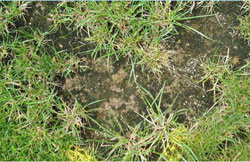Masses of greenish to brownish globs of algae that form on the soil surface can damage turf by suffocating grass plants and roots. As these gelatinous deposits dry, they form tough black crusts that crack and peel off in sheets. This problem is more common in thin, shaded, over-fertilized, and over-watered turf than in well-drained, healthy turf. Compacted areas, especially where water stands, are especially susceptible. Proper soil preparation prior to seeding or laying sod, selecting the proper grass for the site, fertilizing properly and following other proper cultural techniques helps reduce problems with algae. Refer to CSU Extension fact sheet 7.202 “Lawn Care” for more detailed information on lawn care.
 Maintaining a thick turf even in areas where shade is a problem, and avoiding water-logged soil and over-watering reduces problems with algae. Watering in late afternoon or early evening has been reported to increase problems with algae. Improving drainage through a vigorous aeration/core cultivation program may also be helpful. The fungicide Fore (mancozeb) is labeled for the management of algae.
Maintaining a thick turf even in areas where shade is a problem, and avoiding water-logged soil and over-watering reduces problems with algae. Watering in late afternoon or early evening has been reported to increase problems with algae. Improving drainage through a vigorous aeration/core cultivation program may also be helpful. The fungicide Fore (mancozeb) is labeled for the management of algae.
For more information, see the following Planttalk Colorado™ scripts:
For more information, see the following Colorado State University Extension fact sheet:



